The Hawk Street Viaduct
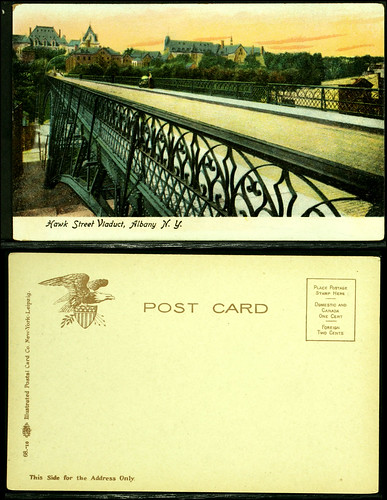 A few weeks back Paula at Albany Daily Photo wrote about the Hawk Street Viaduct, which prompted me to dig up an old postcard I’d put in the files, waiting for a reason to figure out just what the Hawk Street Viaduct was, because I’d never heard of it other than this postcard. For 82 years, this marvel of engineering loomed over Sheridan Hollow, connecting Arbor Hill to Capitol Hill, and then it disappeared with hardly a trace. Thanks to the holdings of the Library of Congress and the incredibly valuable Historic American Engineering Record, I’ve found some much more detailed views of the Viaduct, and some of its story.
A few weeks back Paula at Albany Daily Photo wrote about the Hawk Street Viaduct, which prompted me to dig up an old postcard I’d put in the files, waiting for a reason to figure out just what the Hawk Street Viaduct was, because I’d never heard of it other than this postcard. For 82 years, this marvel of engineering loomed over Sheridan Hollow, connecting Arbor Hill to Capitol Hill, and then it disappeared with hardly a trace. Thanks to the holdings of the Library of Congress and the incredibly valuable Historic American Engineering Record, I’ve found some much more detailed views of the Viaduct, and some of its story.
Read more about this “monument of another age . . . “
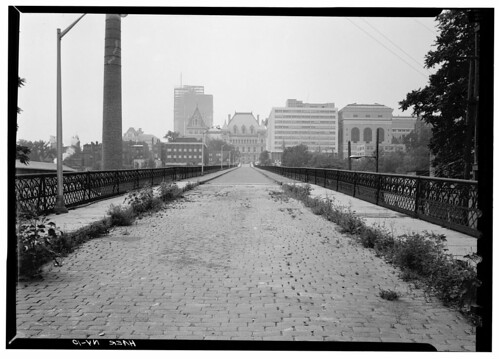 According to the HAER records, the Hawk Street Viaduct, originally called the Hawk Street Bridge, was “a monument of another age, it has been condemned as unsafe, and only pedestrians now (September 1969) cross over this rusted, dilapidated structure . . . According to the commemorative plaques attached to the bridge, it was built in 1889-1890 by the Hilton Bridge Construction Company of Albany, when Edward A. Maher was Mayor. the bridge was rebuilt in 1925 under the leadership of Mayor William S. Hackett. By 1949 extensive deterioration of the bridge made it necessary to reduce its allowable carrying load from ten to three tons. In 1958, the city appropriated $250,000 for reconstruction, but the plan was abandoned. Records of the bridge’s construction and maintenance were lost.” The bridge was beautifully on axis with the Washington Avenue entrance of the Capitol, providing a view that no longer exists. In this picture, probably July 1970, you can see the Corning Tower rising up over what was then called the South Mall. You can also see a large brick smokestack to the left, visible again here:
According to the HAER records, the Hawk Street Viaduct, originally called the Hawk Street Bridge, was “a monument of another age, it has been condemned as unsafe, and only pedestrians now (September 1969) cross over this rusted, dilapidated structure . . . According to the commemorative plaques attached to the bridge, it was built in 1889-1890 by the Hilton Bridge Construction Company of Albany, when Edward A. Maher was Mayor. the bridge was rebuilt in 1925 under the leadership of Mayor William S. Hackett. By 1949 extensive deterioration of the bridge made it necessary to reduce its allowable carrying load from ten to three tons. In 1958, the city appropriated $250,000 for reconstruction, but the plan was abandoned. Records of the bridge’s construction and maintenance were lost.” The bridge was beautifully on axis with the Washington Avenue entrance of the Capitol, providing a view that no longer exists. In this picture, probably July 1970, you can see the Corning Tower rising up over what was then called the South Mall. You can also see a large brick smokestack to the left, visible again here:
That stack was part of a power plant then, and it’s still part of the Sheridan Avenue Steam Plant, which provides steam heat to the Empire State Plaza. I drive past the stack nearly every day. The railing in that Google Street View is a sad and certainly accidental echo of the structure that preceded it.
More from HAER:
“Despite its almost obscure record, the Hawk Street Viaduct is significant in the physical and social history of Albany. Spanning the raving between Capitol Hill and Arbor Hill, it connected the fine residential section, which had grown up around the government buildings, with working class neighborhoods. A canal at one time ran through the ravine, but it has been filled in and displaced by Sheridan Avenue.
“In the late nineteenth century, the Hawk Street Viaduct provided a solution to both a social and an engineering problem. It was necessary to establish direct access and communication between the separate camps of the city, but neither the city nor state governments worked rapidly toward a solution. All through the 1880s the state legislature rejected a bill authorizing a viaduct across the ravine, which, by that time, was at least an engineering and a financial possibility. Two successive mayors, city councils, and corporation counsels also opposed this logical civic improvement idea. The legislature finally approved the project in 1888, thanks to the efforts of Maurice Cranwell, the ‘father of the bridge,’ who facilitated the ‘poor man’s short cut to town.’ The City of Albany at that time appropriated $125,000; only $107,000 of it was used for the construction costs which actually were only $90,000.
“As a significant engineering achievement, the construction of the Hawk Street Viaduct in 1889-90 heralded the use of the cantilever arch. It was regarded as ‘a genuine architectural wonder,’ and was much admired and copied in Europe and America, in spit of the fact that it was a dry-land structure and lacked the romance and boldness of bridges across water . . .
“A contemporary writer described the Hawk Street Viaduct as ‘a daring experiment in bridge construction.’ At its highest point the viaduct is 79 feet above the street level blow. A power plant on Sheridan Avenue barely rises to the level of the roadway. Undoubtedly, this elevated featured has been an invitation to the would-be suicide, and a considerable number are reported over the years to have leaped to their death from the railing to the pavement below.
“The original structure novelty of the viaduct has long since been eclipsed, and its abandoned, dilapidated appearance adds a note of sadness to the general disarray of central Albany as it undergoes reconstruction and renewal. The vast South Mall and its gigantic buildings rising slowly on Capitol Hill on one side of the Hawk Street Viaduct is matched by the leveled surface that covers much of Arbor Hill on the other side. As these areas are rebuilt, the need for a new bridge linking them across the Sheridan Avenue ravine will become more urgent. It is expected that in due course a new and more modern viaduct will rise across Swan Street, a block west of the Hawk Street Viaduct. Indeed, there may be need of another bridge across the raving at a point closer to downtown Albany east of Hawk Street. All of this points to the growing importance and utility of a crossing at this strategic site, which has been evident since the last century.”
 HAER gives some background on the engineer, Elnathan Sweet, as well: “Elnathan Sweet (1837-1903), the designer and engineer of the bridge, was also president of the Hilton Bridge Construction Company, its builders. Sweet’s contribution was significant both professionally and technically. In many respects the Hawk Street Viaduct was the most important engineering project in his long and diversified career. Born in Cheshire, Massachusetts in the Berkshire Mountains, Sweet received a degree in civil engineering from Union College, Schenectady in 1859. It was the age of railroad building, and he traveled westward to participate in some of its more ambitious undertakings; he was particularly involved with the construction of the Rock Island and Northern Pacific railroads. In 1875 he came to Albany where Governor Samuel J. Tilden engaged him to help clean up the scandalous activities of the contracts on the state canals. Sweet was subsequently elected State Engineer of New York and served until 1887. Returning to private engineering practice, he became president of the Hilton Company. In the Hawk Street Viaduct design he introduced some novel features, most important to the combination of the arch with the cantilever in one structure.”
HAER gives some background on the engineer, Elnathan Sweet, as well: “Elnathan Sweet (1837-1903), the designer and engineer of the bridge, was also president of the Hilton Bridge Construction Company, its builders. Sweet’s contribution was significant both professionally and technically. In many respects the Hawk Street Viaduct was the most important engineering project in his long and diversified career. Born in Cheshire, Massachusetts in the Berkshire Mountains, Sweet received a degree in civil engineering from Union College, Schenectady in 1859. It was the age of railroad building, and he traveled westward to participate in some of its more ambitious undertakings; he was particularly involved with the construction of the Rock Island and Northern Pacific railroads. In 1875 he came to Albany where Governor Samuel J. Tilden engaged him to help clean up the scandalous activities of the contracts on the state canals. Sweet was subsequently elected State Engineer of New York and served until 1887. Returning to private engineering practice, he became president of the Hilton Company. In the Hawk Street Viaduct design he introduced some novel features, most important to the combination of the arch with the cantilever in one structure.”
The structure was dismantled in July 1970, and the photos below appear to have been made during this process.
The houses at the end of the Hawk Street are still there, as are the buildings at the corner of Hawk and Clinton Avenue.

![Reblog this post [with Zemanta]](http://img.zemanta.com/reblog_e.png?x-id=dabe15d2-007d-4ef2-b548-438943372854)
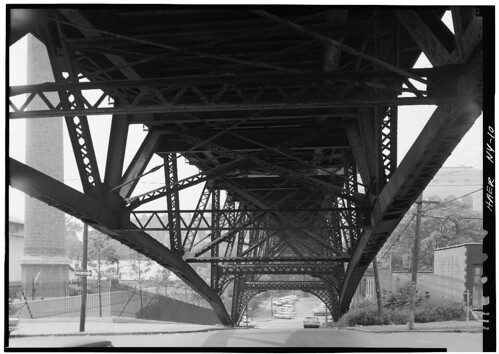
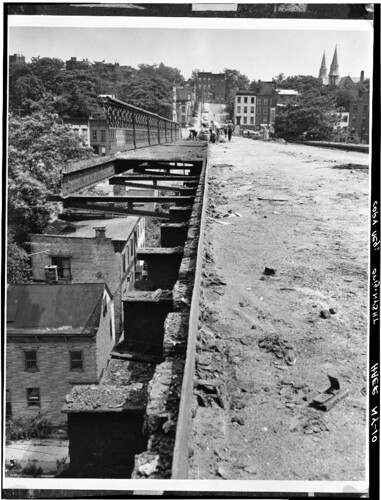
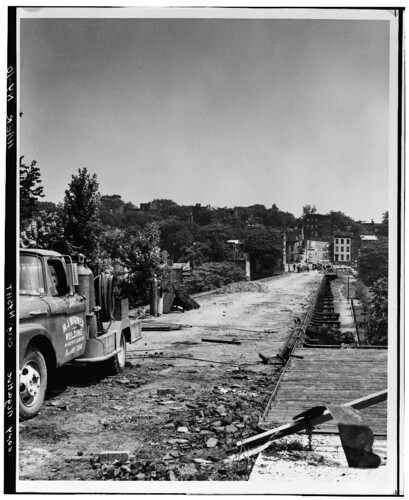
Good Christ, that’s amazing stuff!!! I pride myself on my arcane knowledge of Albany stuff, and even worked for awhile at the Albany Institute looking down into Sheridan Hollow, and I had never heard of this . . . when I saw the first pictures, I figured it had been torn down a century ago, so was even more agog to know it lasted until 1970. Great post! Great story! Great history!
Thank you, sir. I’m torn between making these short enough to read, and long enough to include the ridiculously interesting (to me) details.
Since this post I remembered that Elnathan Sweet is buried in Albany Rural Cemetery.
I’d always opt for the ridiculous details . . . that’s what makes it worth reading. For geeks like me, anyway.